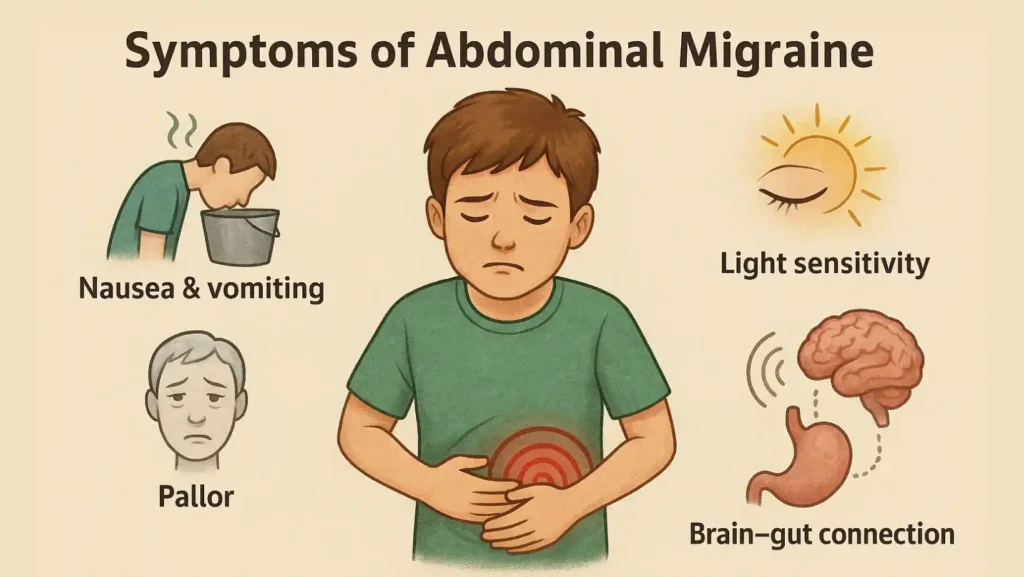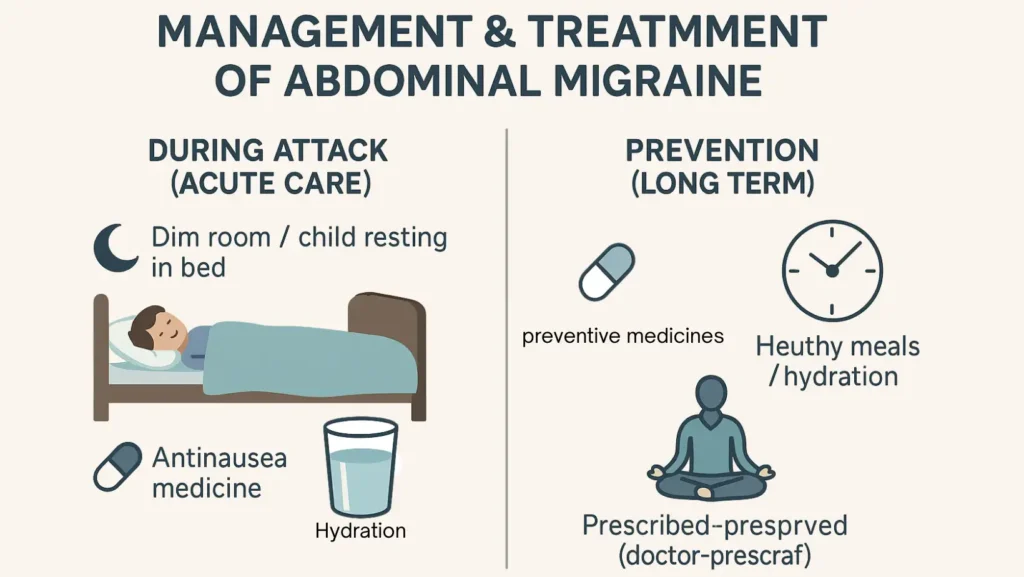An abdominal migraine is a recurring pain disorder that hits the belly instead of the head. Each attack brings intense, midline pain. Symptoms can include nausea and abdominal discomfort and paleness. Children often show this pattern first. Doctors see a clear link to later head pain in many patients.
Table of Contents
ToggleOverview
What Is An Abdominal Migraine?
An abdominal migraine is a health condition defined by repeated episodes of belly pain. Each episode lasts from two to 72 hours. Attacks include at least two of these signs: nausea, vomiting, anorexia, or pallor. Between attacks, children usually feel well. The diagnosis relies on the pattern of attacks and normal tests when the child is well.
Who Do Abdominal Migraines Affect?
Most cases appear in children (under 10 years, school-aged). Many pediatric cases fall under pediatric migraine disorder patterns. Some people continue to have symptoms into adulthood. The condition called abdominal migraine in adults is less common but real. A family history often points to migraine risk.
What Are the Risk Factors for Abdominal Migraine?
Risk factors include a family history of migraine, poor sleep / irregular sleep, dehydration, motion sickness, and mood issues such as anxiety or depression. Nervous system differences also matter. Some experts label the condition as a functional gastrointestinal disorder because the gut works oddly despite normal tests. Keep a simple diary. It helps spot triggers.
How Common Is Abdominal Migraine?
In children, estimates vary. Some studies report a few percent of school-aged kids show this pattern. Many experts believe cases go unrecognized. The adult prevalence is low, and data remain limited.
Symptoms And Causes
What Are the Symptoms of Abdominal Migraine?

Typical abdominal migraine symptoms include deep, midline belly pain near the navel. Kids often feel nausea and may have vomiting. The child may look pale, showing pallor (pale appearance). Some show photophobia (light sensitivity) or phonophobia (noise sensitivity). Attacks come on, reach peak, and then stop. Normal health returns between attacks.
What Causes Abdominal Migraines?
No single cause explains every case. The best idea ties the gut and brain together via the brain-gut connection. Many studies point to nervous system hypersensitivity and shifts in neurotransmitters / serotonin. Genetic links also matter. The same biology that causes head pain likely drives belly pain in these attacks. Some children later develop classic migraine headaches (general).
What Triggers Abdominal Migraines?
Common triggers include poor sleep / irregular sleep, stress and abdominal migraine, dehydration, and motion. Missing meals and exercise in some children may trigger attacks. Certain foods matter. Avoid high-amine foods (chocolate, cheese, citrus, salami, ham) and MSG / food additives if these match a child’s pattern. Keep a sleep and food log to find personal triggers.
Diagnosis And Tests
How Is Abdominal Migraine Diagnosed?
A doctor makes an abdominal migraine diagnosis by listening to the attack pattern and checking the child when well. The ICHD-3 criteria guide clinicians. They require multiple attacks, midline pain, associated nausea or vomiting, and normal exam between episodes. Tests may be done to rule out other causes.
Doctors often order basic blood work and stool tests. Imaging, such as ultrasound or MRI, may appear when tests do not match the story. They look to exclude stomach ulcers, Crohn’s disease, Irritable bowel syndrome (IBS), or bladder / kidney conditions. If these tests stay normal, the diagnosis leans toward abdominal migraine.
Tests To Consider
- Complete blood count and basic chemistry.
- Stool tests for infection.
- Ultrasound for structural issues.
- Endoscopy only if red flags appear.
If tests are normal, doctors revisit the attack pattern and personal or family migraine history. This approach reduces missed diagnoses.
Management And Treatment

How Is Abdominal Migraine Treated?
Good care uses two plans. Treat the attack. Prevent future attacks. This is the core of abdominal migraine treatment. For attacks, rest in a dim room and give fluids. Medicines include antinausea medications and simple pain relief. For some older children and adults, triptans (serotonin receptor agonists) help. For prevention, doctors may suggest medicines such as cyproheptadine, pizotifen, propranolol, or flunarizine. Evidence shows these options can reduce frequency and severity.
Strategies To Prevent Abdominal Migraines
Prevention focuses on habits and targeted drugs. Key strategies include: steady sleep, regular meals, hydration, and stress control. Avoid known food triggers. Limit caffeine. Try a daily diary to spot patterns. When lifestyle steps fail, preventive drugs may start under specialist care.
Medications To Prevent Episodes
Common preventive medicines include cyproheptadine, pizotifen, propranolol, and flunarizine. Doctors may also try riboflavin or low-dose antidepressants in certain cases. Choice depends on age, side effects, and other health issues. Many medications are used off-label for this condition. Studies show benefits but call for larger trials.
Treatment For Abdominal Migraine Attacks
During an attack, give fluids and rest. Use antinausea medications if vomiting occurs. Offer acetaminophen or age-appropriate measures for pain. Avoid frequent NSAIDs unless advised, since NSAIDs (ibuprofen, aspirin) may help but can cause harm with overuse. In older patients, triptans (serotonin receptor agonists) sometimes stop attacks early.
Comparison Table
| Condition | Typical Age | Key Features | How Tests Help |
| Abdominal Migraine | Children, teens | Recurrent midline pain, nausea, pallor, normal tests | Normal labs support diagnosis. Pattern matters. |
| Irritable Bowel Syndrome (IBS) | Teens, adults | Pain with bowel changes, bloating | Abnormal bowel function suggests IBS. Tests are often normal. |
| Cyclic Vomiting Syndrome | Young children | Repeated severe vomiting spells | Patterns of vomiting and normal tests point to this. Cyclic vomiting syndrome |
| Crohn’s Disease | Any, often teens | Weight loss, fever, chronic diarrhea | Blood tests, imaging, and endoscopy show inflammation. Crohn’s disease |
| Stomach Ulcers | Teens, adults | Localized pain, bleeding | Endoscopy can find an ulcer. Stomach ulcers |
Outlook And Prognosis
What Is the Prognosis for Abdominal Migraine?
Many children improve over time. Some develop classic headaches later. With simple prevention, attacks may drop in number and intensity. Adults with this diagnosis vary. Long-term quality of life improves with a clear plan. Regular follow-up helps track changes.
Living With
How Can I Help My Child With Abdominal Migraine?
Keep a short log of sleep, food, and attacks. Offer quiet rest during episodes. Keep fluids and light snacks ready. Teach the child to tell an adult early. Talk calmly with teachers so school plans match needs. Consider Cognitive behavioral therapy (CBT) when stress plays a role. Bright light or noise can worsen symptoms.
Abdominal Migraine in Adults: What To Know
If you are an adult with long-term belly pain and nausea, ask about abdominal migraine in adults. Adults may wait longer for diagnosis. Treatments mirror pediatric plans but adjust for adult health. Ask a headache or GI specialist if typical tests fail to explain attacks.
When Should You See a Healthcare Provider?
Seek care for frequent attacks, weight loss, fever, blood in stool, or long vomiting. Also see a doctor when pain changes pattern or when tests show abnormal results. If the child shows signs of severe dehydration, seek immediate care.
The Bottom Line
abdominal migraine sits at the crossroad of gut and brain. It causes clear belly pain episodes with nausea, vomiting, or pallor. The pattern matters more than a single test. Simple lifestyle steps help many. For frequent attacks, prevention medicines work for many children and some adults. Early, calm action reduces school absences and stress.
FAQs
How do you treat abdominal migraines?
Treat attacks with rest, fluids, and antinausea medicines. Use simple pain relief. Prevent attacks with lifestyle steps and, when needed, medicines like propranolol or pizotifen under doctor care.
What does abdominal migraine pain feel like?
It feels like deep, steady pain near the belly button. The pain can grow strong. It often comes with nausea, vomiting, and a pale look during attacks.
What causes abdominal migraines?
The cause links the brain and gut. Nervous system sensitivity and shifts in serotonin may trigger attacks. Genes, sleep, stress, and diet also affect risk and frequency.
Are abdominal migraines a neurological disorder?
Yes. They belong to the migraine family and stem from brain and nervous system changes. They overlap with functional gut disorders and classic migraine types.
What other conditions mimic abdominal migraines?
IBS, cyclic vomiting syndrome, Crohn’s disease, stomach ulcers, and bladder or kidney conditions can look similar. Tests help separate these causes from abdominal migraine.
Will abdominal migraine go away?
Many children improve by adolescence. Some develop classic headaches instead. Adults may have ongoing symptoms. Treatment lowers attack frequency and improves daily life.
How is abdominal migraine diagnosed?
Doctors use medical history and exam. ICHD-3 criteria guide diagnosis. Tests rule out organic disease. Normal tests plus the attack pattern confirm the diagnosis.
About The Author

This article is medically reviewed by Dr. Chandril Chugh, Board-Certified Neurologist, providing expert insights and reliable health information.
Dr. Chandril Chugh is a U.S.-trained neurologist with over a decade of experience. Known for his compassionate care, he specializes in treating neurological conditions such as migraines, epilepsy, and Parkinson’s disease. Dr. Chugh is highly regarded for his patient-centered approach and dedication to providing personalized care.
→ Book a consultation to discover which remedies suit your needs best.






